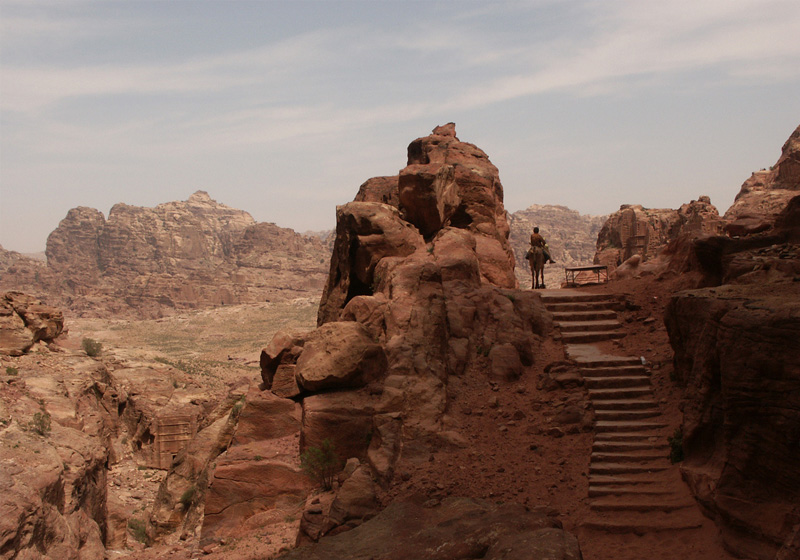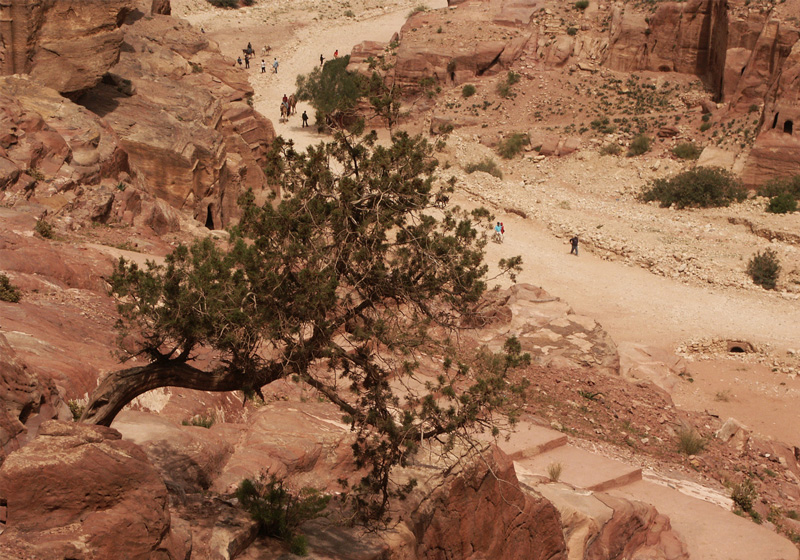Petra and Beyond

For many, Petra ends at Qasr al Bint. For those insisting to do all the listed monuments, and who are more fit, Petra ends at Al Dair, or at Nabi Haroun after a full-day walk. For anyone to claim a good knowledge of Petra, at least one week of hard walking is needed.
After the third day, finishing most of the sites listed in tourists' books, one develops an urging curiosity to find out what hides behind Petra, how this vast site ends towards the west and meets the wilderness at Wadi Araba.
It is amazing, and alarming, how drastically the vegetation changes once you leave the tourists' tracks. The less treaded passages have kept their thick vegetation; both plants and rocks appear in vibrant color intensity for not being tarnished by the dust of the tourists' traffic.
After a hard climb, the terrain opens up into the flat, open, and breathtakingly elevated mountaintop of Jabal Al Barra. Obviously this location is favored by shepherds for good grazing, and the name, Al Barra "the open place" is given to similar geomorphology used for gazing in other parts of Jordan –there is a Barra above Wadi Dana to the south.
Once atop, the distanced view of Al Dair is quite stunning. The monument appears like a miniature sand castle sticking out from a very rugged terrain. From this spot you can also see the strip of carved façades, the Corinthian Tomb and the Palace Tomb, one and a half kilometer away. Walking tourists emerge in some distanced spots, like a line of ants on freshly ploughed rust-red soil.
To the southwest, Nabi Haroun presents an imposing tip to a mountain twice the height of Barra. From this mid-height view, the white washed, dome caped structure of Haroun's Tomb appears against the dark-blue sky with its violet-tint shady side facing you. Backlit, its edges are highlighted in warm sun-gold and its dome framed by a shimmering thin crescent.
Barra is a like a hidden garden of intact Petra flora. It has vast stretches of flat rock, like a pavement, created along a layer of slate-like crust, capping one of the division of the "Um Ishrin" sandstone of the mid to late Cambrian period formed under water 540- 520 million years ago. From the hard landscaping design, furnished by Petra's special geology, an impressive selection of native plants, some endemic to the Sharaah Mountains, intensify the unique character of this place. Out of the geometric cracks of chocolate sandstone crust, grows some of Jordan's best wild carnation (Dianthus judaicus).
Hanging from vertical red cliffs, are the silver-blue caper bushes (Capparis cartilaginea); the blueness of their leaves is so intense, against the redness of Petra, that you start questioning the color calibration of your eyes. Standing like sculptures are juniper trees with their twisted trunks, in shiny lead, adding to the crisp air a scent of juniper oil as a hint of cleanliness.

Petra is a site of natural heritage in the first place; its rocks and plants present the bigger canvas on which the Nabataeans added their architecture. While their monuments have changed in time, their environment, that inspired them more than two thousand years ago, is what we see today –without much change. Protecting the bigger context of the endemic Nabataean civilization, and understanding its qualities as well as any possible threats, is the only way to understand the Nabataeans and their gift of Petra.
Start early in the morning, walk towards the restaurant just north of Qasr al Bint. Carefully walk into the valley heading westward keeping in mind that this is the only outlet of a huge water catchments area, which includes all of Petra and Wadi Musa. After one kilometer, past the monumental quarries, to your right, north of the wadi, look for goat tracks heading southward, on a steep side of another wadi running north-south. From behind Jabal Um al Biyara, west of it, keep climbing southward, and after about one kilometer you should arrive to the flattop vast area of Jabal al Barra. Al Barra is a tough walk. It takes a full day and can be combined with Nabi Haroun. You can descend from Barra towards the east, joining the tourist track at Wadi Maghariq. Make sure you don't get stuck off the beaten track after sunset.